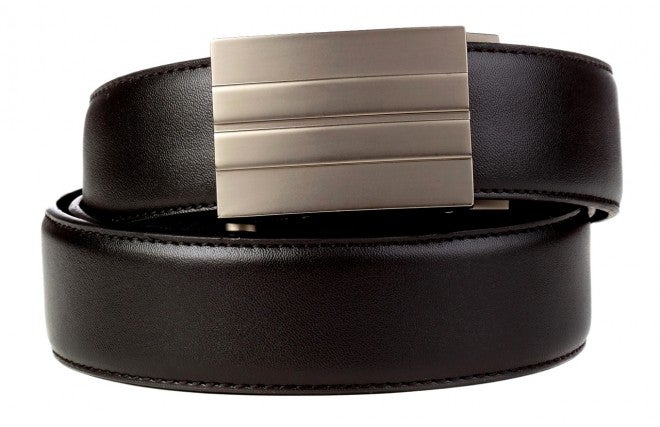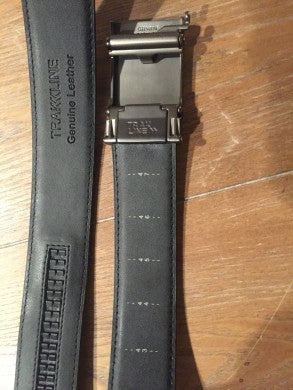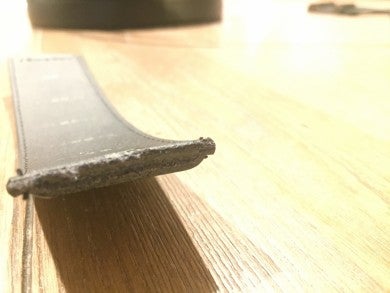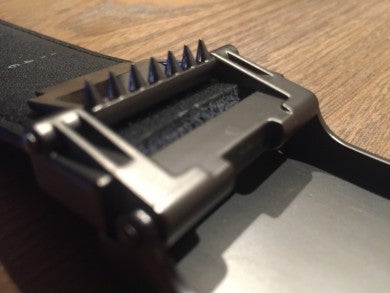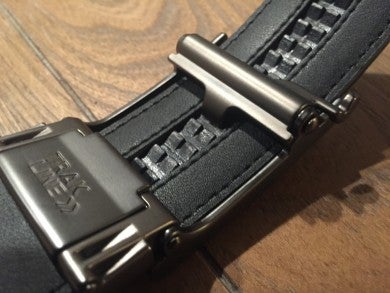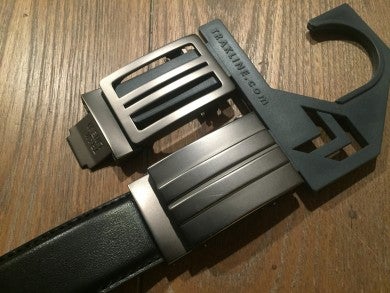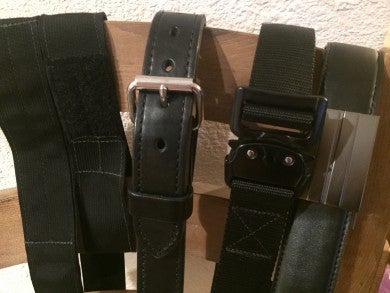KORE Trakline Belt
This year has been the “year of the belts” for me. I have had four belts for review this year, starting with the Lenwood Leather Belt, which has become my daily go to, and the GPM Kit Belt which is my main hiking and 3-Gun belt.
Along comes the Kore Essentials “Trakline” belt (I was sent the X2 Gun Belt to review). KORE Essentials, like GPM Kit, is working some innovation into the technology used to hold up your pants.
Construction and Operation
The Trakline seems like an ordinary belt with an ordinary buckle, but it ships in a do-it-yourself fashion. The belt itself was coiled in a little cinch bag, which also contained the buckles. The belt is advertised as being able to fit from twenty-four inches all the way up to fifty-four inches.
The belt has two ends. Seriously, Tom, really? Two SEPARATE ends? Yes, readers, two ends, and the ends are important. One of the ends is flat and the other end has the “track”. This is where it is important to quickly scan the directions as you will be cutting away material (unless, of course, you are a fifty-four inch waist). The flat end of the belt (which is where the buckle will be) is conveniently marked (on the inside) in one inch increments. Find your preferred length, and trim away, as straight as you can, with sharp scissors. Obviously if you are going to be carrying you need to add a couple of extra inches to accommodate your weapon.
Select your buckle (if you received more than one) and feed the flat end into the opening. Then you simply lower the “lever” which sends the aggressive teeth into the belt material.
To wear the belt, you thread as normal through your belt loops (unlike the non-standard GPM Kit Belts). Here is where the difference occurs. Rather than being like a heel bar where you weave the belt through the buckle and anchor with a pin through a hole, the belt works a lot like the ratcheting mechanism on handcuffs or zip ties. You feed the end of the belt through the buckle and the spring-loaded lock slides over the ramps of the track, and drops into the grooves. It will securely catch and prevent the belt from backing out, and each “click” is about one quarter of an inch, giving you a lot finer control than you have with traditional belts.
The plastic hanger that comes in the package is also a designated way to hang the belt in your closet as it has the same ramps and grooves as the track on the belt. As an added bonus you can use the backside of the buckle as a bottle opener. That is actually part of the design… 😉
Observations
Twenty-four inches to fifty-four inches? My initial thought was there was going to be some sort of weird tuck, or I would have miles of belt tail left over. That fear was relieved by carefully trimming the belt to size. I actually trimmed it a number of times to experiment (and get pictures).
There are specific buckles that work with the X1 and X2 gun belts due to the different width of the belt. That said there are still a bunch of options—you should be able to find something that matches your style.
After I trimmed and seated the buckle, my concern was that the amount of belt anchored to the buckle was not very much. It could not have been more than a quarter of an inch in the anchor. The X2 Gun Belt version is rated to hold around three pounds of stuff. So, pick and choose your EDC carefully. It actually does pretty well with a compact pistol and spare magazine, but I wouldn’t confuse it for a duty belt and hang a radio and other heavy bits from it. I would guess the three pound rating is based on the position of the anchoring teeth in relation to the end of the belt.
One of the other benefits of no belt holes is that you won’t get the stretching and deformation that comes with long extended use. I imagine over time you may get some rounding of the teeth on the track, but that should be pretty easily solved by trimming a bit from the back end of the belt and shifting your anchor point (or force feeding yourself a bunch of Krispy Kremes).
I wore the belt to a number of functions that required dress clothing, and this was one of the first times I felt comfortable wearing my sidearm. Normally belts with a full inch between adjustments leave either a little bit of slop, or make the belt a hair too tight. The design and construction of this belt allows to you really fine tune the fit and adjustment.
I felt that the belt is a little too dressy to be my range belt, or my general heavy use belt. Not that it couldn’t serve in those capacities, but I wanted to keep a nice belt for use with my suits.
Conclusion
While I love my Lenwood belt, it is a bit heavy to wear with more “delicate” dress pants. The KORE Trakline fits that niche nicely. The buckles are pretty neutral and complement the suits that I own, and the belt itself is plain and functional.
It is also nice that you can tune the belt specifically to your own anatomy both from a gross cut of size, to fine increments during anchoring. This is probably the best overall feature of the belt. I would really like to see a collusion with Lenwood and KORE to make a beefy, heirloom leather belt with the awesome adjustability of the Trakline.
KORE has done a great job of re-imagining the belt and how to manage it both on and off the body. The belt is in the $80 price range (though at the time of writing it was on sale for $60).
You can find more information at their website (as well as order directly from them): http://www.koreessentials.com/x2-gun-buckle-belt/
 Your Privacy Choices
Your Privacy Choices
